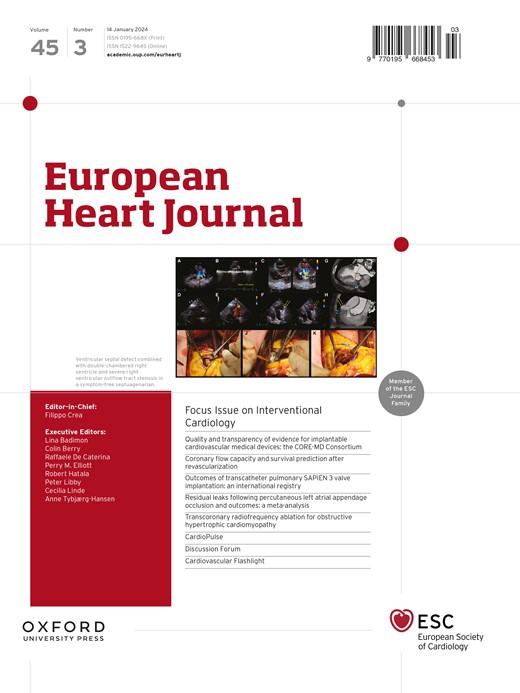Checkpoint kinase Wee1 activation drives inflammation and hypertrophy through the protein kinase B/phosphoinositide 3-kinases-nuclear factor κB pathway in cardiomyocytes.
IF 37.6
1区 医学
Q1 CARDIAC & CARDIOVASCULAR SYSTEMS
引用次数: 0
Abstract
BACKGROUND AND AIMS Hypertensive heart failure has an urgent need for new therapeutic targets. Protein kinases act as key regulators in cellular actions relevant to cardiac pathophysiology. This study identified a protein kinase, Wee1 G2 checkpoint kinase (Wee1), being activated and involved in this disease. METHODS RNA-seq-based kinase enrichment analysis was used to identify the involved kinase pathways. Cardiomyocyte-specific Wee1-deficiency mice with chronic angiotensin II (Ang II) infusion and transverse aortic constriction (TAC) were utilized to develop cardiac remodelling. RNA-seq and co-immunoprecipitation were used to explore the mechanism and substrate of Wee1. RESULTS Kinase enrichment analysis and experimental evidence revealed that Wee1 phosphorylation at Ser642, but not increased expression, was observed in hypertrophic cardiac tissues from both mice and human patients. Knockdown, pharmacological inhibition, or mutational inactivation of Wee1 significantly alleviated Ang II-induced cardiomyocyte injuries. RNA-seq analysis showed that phosphoinositide 3-kinases/protein kinase B (AKT) pathway mediated the function of Wee1 in cardiomyocytes. Mechanistically, the phosphorylated Wee1 directly binds to the PHD domain of AKT to phosphorylate AKT inducing AKT/phosphoinositide 3-kinases-nuclear factor κB signalling pathway activation and subsequent inflammation and hypertrophy in cardiomyocytes. Cardiomyocyte-specific Wee1 deficiency was found to protect against cardiac inflammation, remodelling, and dysfunction in mice subjected to transverse aortic constriction or Ang II infusion. Pharmacological Wee1 inhibition also attenuated Ang II-induced cardiac remodelling in mice. CONCLUSIONS Cardiomyocyte Wee1 activation drives inflammation and hypertrophy by directly phosphorylating AKT and activating AKT-nuclear factor κB pathway. This study identifies Wee1 as a new upstream kinase of AKT and a potential therapeutic target for hypertensive heart failure.检查点激酶Wee1的激活通过蛋白激酶B/磷酸肌苷3-激酶-核因子κB途径在心肌细胞中驱动炎症和肥大。
背景和目的:高血压性心力衰竭迫切需要新的治疗靶点。蛋白激酶在与心脏病理生理相关的细胞活动中起关键调节作用。本研究发现一种蛋白激酶,Wee1 G2检查点激酶(Wee1)被激活并参与了该疾病。方法采用基于srna -seq的激酶富集分析方法,鉴定参与的激酶途径。心肌细胞特异性wee1缺乏症小鼠经慢性血管紧张素II (Ang II)输注和主动脉横缩(TAC)进行心脏重构。采用RNA-seq和共免疫沉淀法探讨Wee1的作用机制和底物。结果皮肤酶富集分析和实验证据显示,在小鼠和人类肥厚心脏组织中,Wee1的Ser642位点磷酸化,但未增加表达。Wee1基因敲低、药理抑制或突变失活均可显著减轻Angⅱ诱导的心肌细胞损伤。RNA-seq分析显示,磷酸肌肽3-激酶/蛋白激酶B (AKT)通路介导心肌细胞中Wee1的功能。在机制上,磷酸化的Wee1直接结合到AKT的PHD结构域,磷酸化AKT,诱导AKT/磷酸肌肽3-激酶-核因子κB信号通路激活,导致心肌细胞炎症和肥厚。研究发现,心肌细胞特异性Wee1缺乏对主动脉横缩或输注angii小鼠的心脏炎症、重构和功能障碍具有保护作用。药理Wee1抑制也能减轻Ang ii诱导的小鼠心脏重构。结论心肌细胞Wee1的激活通过直接磷酸化AKT和激活AKT-核因子κB通路来驱动炎症和肥厚。本研究发现Wee1是AKT的一个新的上游激酶,是高血压心力衰竭的潜在治疗靶点。
本文章由计算机程序翻译,如有差异,请以英文原文为准。
求助全文
约1分钟内获得全文
求助全文
来源期刊

European Heart Journal
医学-心血管系统
CiteScore
39.30
自引率
6.90%
发文量
3942
审稿时长
1 months
期刊介绍:
The European Heart Journal is a renowned international journal that focuses on cardiovascular medicine. It is published weekly and is the official journal of the European Society of Cardiology. This peer-reviewed journal is committed to publishing high-quality clinical and scientific material pertaining to all aspects of cardiovascular medicine. It covers a diverse range of topics including research findings, technical evaluations, and reviews. Moreover, the journal serves as a platform for the exchange of information and discussions on various aspects of cardiovascular medicine, including educational matters.
In addition to original papers on cardiovascular medicine and surgery, the European Heart Journal also presents reviews, clinical perspectives, ESC Guidelines, and editorial articles that highlight recent advancements in cardiology. Additionally, the journal actively encourages readers to share their thoughts and opinions through correspondence.
 求助内容:
求助内容: 应助结果提醒方式:
应助结果提醒方式:


